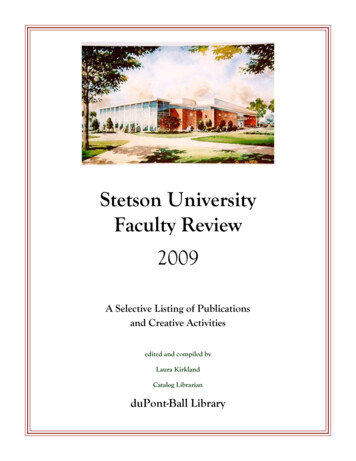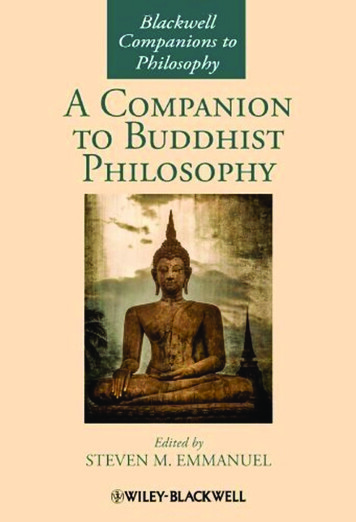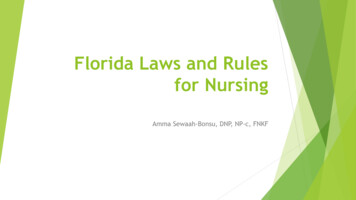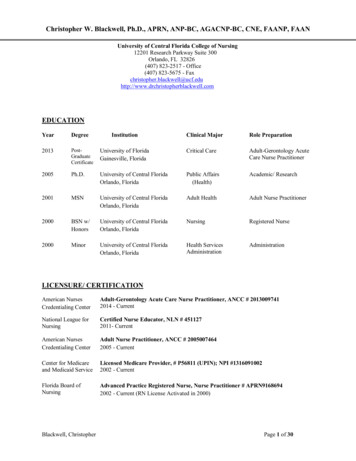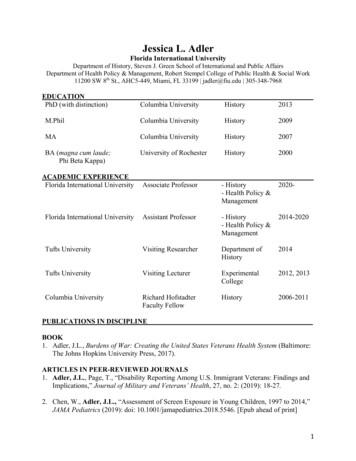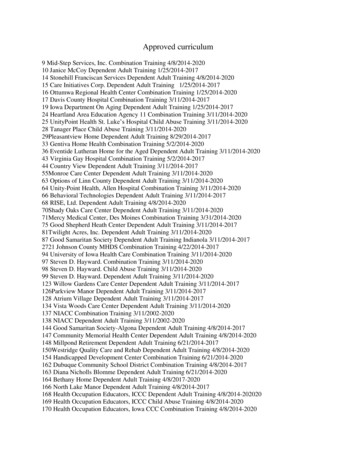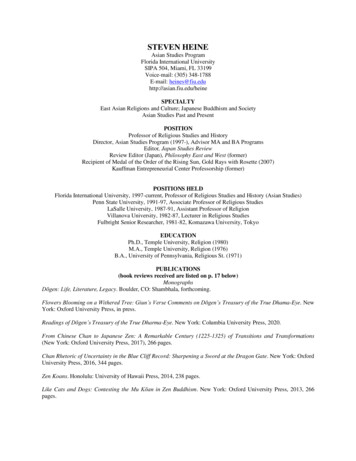
Transcription
STEVEN HEINEAsian Studies ProgramFlorida International UniversitySIPA 504, Miami, FL 33199Voice-mail: (305) 348-1788E-mail: ast Asian Religions and Culture; Japanese Buddhism and SocietyAsian Studies Past and PresentPOSITIONProfessor of Religious Studies and HistoryDirector, Asian Studies Program (1997-), Advisor MA and BA ProgramsEditor, Japan Studies ReviewReview Editor (Japan), Philosophy East and West (former)Recipient of Medal of the Order of the Rising Sun, Gold Rays with Rosette (2007)Kauffman Entrepreneurial Center Professorship (former)POSITIONS HELDFlorida International University, 1997-current, Professor of Religious Studies and History (Asian Studies)Penn State University, 1991-97, Associate Professor of Religious StudiesLaSalle University, 1987-91, Assistant Professor of ReligionVillanova University, 1982-87, Lecturer in Religious StudiesFulbright Senior Researcher, 1981-82, Komazawa University, TokyoEDUCATIONPh.D., Temple University, Religion (1980)M.A., Temple University, Religion (1976)B.A., University of Pennsylvania, Religious St. (1971)PUBLICATIONS(book reviews received are listed on p. 17 below)MonographsDōgen: Life, Literature, Legacy. Boulder, CO: Shambhala, forthcoming.Flowers Blooming on a Withered Tree: Giun’s Verse Comments on Dōgen’s Treasury of the True Dhama-Eye. NewYork: Oxford University Press, in press.Readings of Dōgen’s Treasury of the True Dharma-Eye. New York: Columbia University Press, 2020.From Chinese Chan to Japanese Zen: A Remarkable Century (1225-1325) of Transitions and Transformations(New York: Oxford University Press, 2017), 266 pages.Chan Rhetoric of Uncertainty in the Blue Cliff Record: Sharpening a Sword at the Dragon Gate. New York: OxfordUniversity Press, 2016, 344 pages.Zen Koans. Honolulu: University of Hawaii Press, 2014, 238 pages.Like Cats and Dogs: Contesting the Mu Kōan in Zen Buddhism. New York: Oxford University Press, 2013, 266pages.
Sacred High City, Sacred Low City: A Tale of Religious Sites in Two Tokyo Neighborhoods. New York: OxfordUniversity Press, 2011, 244 pages.Bargainin’ for Salvation: Bob Dylan, A Zen Master? New York: Continuum Books, 2009, 256 pages.Zen Skin, Zen Marrow: Will the Real Zen Buddhism Please Stand Up? New York: Oxford University Press, 2008,217 pages.Did Dōgen Go to China? What He Wrote and When He Wrote It. New York: Oxford University Press, 2006, 293pages.White Collar Zen. New York: Oxford University Press, 2005, 198 pages.Opening a Mountain: Kōans of Zen Masters (includes translations of 60 kōan cases). New York: Oxford UniversityPress, 2001, 200 pages.Shifting Shape, Shaping Text: Philosophy and Folklore in the Fox Kōan (includes translations of several kôancommentaries). Honolulu: University of Hawaii Press, 1999, 312 pages.The Zen Poetry of Dōgen: Verses From the Mountain of Eternal Peace (includes Japanese and Chinese poetrycollections). Boston: Charles E. Tuttle, 1997, 189 pages; rpt. by Mt. Tremper, NY: Dharma Communications Press,reprint 2005.Dōgen and the Kōan Tradition: A Tale of Two Shōbōgenzō Texts (includes translations of Dōgen's "Kattō,""Shinfukatoku," and "Ōsakusendaba" fascicles). Series in Philosophy and Psychotherapy. Albany: State Universityof New York Press, 1994, 329 pages.A Dream Within a Dream: Studies in Japanese Thought (includes a translation of Dōgen's "Muchûsetsumu"fascicle). Series in Asian Thought and Culture. New York: Peter Lang, 1991, 245 pages.A Blade of Grass: Japanese Poetry and Aesthetics in Dōgen Zen (includes the first complete translation of Dōgen'swaka collection, "Sanshōdōei," in a Western language). Series in Asian Thought and Culture. New York: PeterLang, 1989, 171 pages.Existential and Ontological Dimensions of Time in Heidegger and Dōgen (includes a translation of Dōgen's "Uji"[Being-Time] fascicle). Series in Buddhist Studies. Albany: State University of New York Press, 1985, 202 pages.Edited BooksCo-Editor (with Albert Welter and Jin Y. Park, Creating the World of Chan/ Sŏn /Zen: Chinese Chan Buddhism andits Spread throughout East Asia (Leiden: Brill, submitted).Co-Editor (with Pamela D. Winfield), Zen and Material Culture. New York: Oxford University Press, 2017, 316pages.Editor, Dōgen and Sōtō Zen. New York: Oxford University Press, 2015, 319 pages.Editor, Dōgen: Textual and Historical Studies. New York: Oxford University Press, 2012, 263 pages.Co-Editor (with Dale S. Wright), Zen Masters. New York: Oxford University Press, 2010, 291 pages.Co-Editor (with Dale S. Wright), Zen Ritual: Studies of Zen Theory in Practice. New York: Oxford UniversityPress, 2007, 337 pages.Co-Editor (with Dale S. Wright), Zen Classics: Formative Texts in the History of Zen Buddhism. New York: OxfordUniversity Press, 2005, 283 pages.2
Co-Editor (with Dale S. Wright), The Zen Canon: Understanding the Classic Texts. New York: Oxford UniversityPress, 2004, 321 pages.Co-Editor (with Charles S. Prebish), Buddhism and the Modern World: Adaptations of an Ancient Tradition. NewYork: Oxford University Press, 2003, 287 pages.Editor, Zen and the Modern World, a third sequel to Zen and Western Thought by Masao Abe. Honolulu: Universityof Hawaii Press, 2003, 169 pages.Co-Editor (with Dale S. Wright), The Kōan: Texts and Contexts in Zen Buddhism. New York: Oxford UniversityPress, 2000, 321 pages.Editor, Zen and Comparative Studies, part two of a two-volume sequel to Masao Abe's award-winning Zen andWestern Thought. Honolulu: University of Hawaii Press, 1997, 261 pages.Editor, Buddhism and Interfaith Dialogue, part one of a two-volume sequel to Masao Abe's award-winning Zen andWestern Thought. Honolulu: University of Hawaii Press, 1995, 245 pages.Co-Editor (with Charles Wei-hsun Fu), Japan in Traditional and Postmodern Perspectives. Albany: StateUniversity of New York Press, 1995, 334 pages (includes contribution by Nobel Prize winner Kenzaburo Oe).Editor, A Study of Dōgen: His Philosophy and Religion, a collection of essays by Masao Abe (includes mytranslation of three new articles). Albany: State University of New York Press, 1992, 251 pages.Journal Articles“The Role of Live Performance in the Gongan Commentary of the Blue Cliff Record: Reflections on John McRae’sRemarks about a Seminal Chan Buddhist Text,” Pacific World 18 (2016).“When There are no More Cats to Argue About: Chan Buddhist Views of Animals in Relation toUniversal Buddha-Nature,” Journal of Chinese Philosophy 43 (2016).“Dōgen: His Life, Religion and Poetry,” Education About ASIA 20/2 (2015): 33-36.“Does Even a Rat Have Buddha-Nature? Analyzing Key-Phrase (Huatou) Rhetoric for the Wu Gongan,” Journal ofChinese Philosophy 42 (2015).“Ishii Shūdō’s Contributions to Dōgen Studies: Examining Chinese Influences on the Kana and Kanbun Texts,”Japanese Journal of Religious Studies 41/2 (2014): 387–404.“Introduction [as Editor of Special Issue]: Fourth-Wave Studies of Chan/Zen Buddhist Discourse,” Frontiers inHistory of China 8/3 (2013): 309–315.“Unintended Baggage? Rethinking Yuanwu Keqin’s View of the Role of Language in Chan Gongan Discourse,”Frontiers in History of China 8/3 (2013): 316–341.“A Bow to Women’s Wisdom: Receiving the Marrow,” Buddhdharma 11/1 (2013): 77-79.“A Book of Japanese Sources,” Philosophy East and West 63/1(2013): 88-91.“When Dōgen Went to China: Chan Poetry He Did and Did Not Write,” Hsiang Lectures on Chinese Poetry 6(2012): 75-100.“Is it Armageddon, Senor? Dylan’s Zeitgeist of the Endzeit Most of the Time,” Montague Street: The Art of BobDylan 3 (2012): 7-22.3
“Not So Quiet on the Eastern Front: On Deconstructing and Reconstructing Traditional Zen Narratives,” ReligiousStudies Review 37/3 (2011): 155-162;“Historical Hermeneutics of Zen Buddhist Discourse: On Contesting the Mu Kōan,” Religious Studies Review 37/3(2011): 175-179.“Does a Dog Have Buddhanature? Well, Yes and No,” Buddhadharma 9/1 ( 2011):“Yes! We Have No Buddha-Nature: Three Recent Publications on Zen Dialogues,” Japanese Journal of ReligiousStudies 37/2 (2010): 367–376.“Bob Dylan’s Zen Garden: Cross-Cultural Currents in His Approach to Religiosity,” Japan Studies Review 14(2010): 113-133.“A Day in the Life: Two Recent Works on Dōgen’s Shōbōgenzō ‘Gyōji’ [Sustained Practice] Fascicle,” JapaneseJournal of Religious Studies 35/2 (2008).“Is Masao Abe an Original Thinker?”, Buddhist-Christian Studies 28 (2008): 131-134.“From Art of War to Attila the Hun: A Critical Survey of Recent Works on Philosophy/Spirituality and BusinessLeadership,” Philosophy East and West 58/1 (2008): 126-143.“Sites and Rites: Sacred Space in Asia” (with Pamela Winfield), Material Religion 3/2 (2007): 283-286.“A Critical Survey of Works on Zen After Yampolsky,” Philosophy East and West 57/4 (2007, also on OnlineForum of Society for Asian and Comparative Philosophy, Fall 2006): 577-592.“Overcome by Modernity? Three Works By and About Takeuchi Yoshimi,” Journal of Japanese Studies, 33/1(2007): 190-194.“Zen in the Workplace: Applying Anti-Structure to Enhance Structure,” Global Business Languages 9 (2004): 95106.“Critical View of Discourses on the Relation between Japanese Business and Social Values,” Journal of Languagefor International Business 15/2 (2004): 35-48.“Kōans in the Dōgen Tradition: How and Why Dōgen Does What He Does with Kōans,” Philosophy East and West54/1 (2004): 1-19.“The Zen Notion of Mind – or is it No Mind?,” Dao: A Journal of Comparative Philosophy 4/1 (2004): 31-42.“Ch’an Buddhist Kung-Ans as Models for Interpersonal Behavior,” Journal of Chinese Philosophy 30/3-4 (2003).525-540.“Did Dōgen Go to China? Problematizing Dōgen’s Relation to Ju-ching and Chinese Ch’an,” Japanese Journal ofReligious Studies 29/1 (2003): 27-59.“Why Not Dōgen?,” Buddhadharma 1/1 (2002): 71-74.“After the Storm: Matsumoto’s Transition from ‘Critical Buddhism’ to ‘Critical Theology,’” Japanese Journal ofReligious Studies (2001)."The Rhetoric of Authority and Power: Bernard Faure's Contributions to Ch'an/Zen Studies," Religious StudiesReview (1999): 1-5."Dylan And Dogen: Masters of Words and Spirits" (with Taigen Dan Leighton), Kyoto Journal 39 (1999), 4-11.4
"Crossing the Bitchi-Bashi: Constructions and Deconstructions of Japanese Women in American Films," JapanStudies Review 2 (1998), 17-36."Motions and Emotions in Medieval Japanese Buddhism," Journal of Chinese Philosophy (1998), 191-208."Sayonara Can Mean Hello': Rethinking the Butterfly Syndrome in Postwar American Films," Post Script 16/3(1997), 29-47."The Dōgen Canon: Dōgen's Pre-Shōbōgenzō Writings and the Question of Change in His Later Works," JapaneseJournal of Religious Studies 24/1-2 (1997), 38-85."Philosophical and Rhetorical Modes of Zen Discourse: Contrasting Nishida's Logic and Kôan Poetry," BuddhistChristian Studies 11 (1997), 3-22."Putting the Fox' Back into the Wild Fox Kōan': On the Intersection of Philosophical and Popular ReligiousElements in the Ch'an/Zen Kôan Tradition," Harvard Journal of Asiatic Studies 56/2 (1996), 257-317."Critical Buddhism and the Problem of Philosophical Syncretism," Asian Philosophy 4/2 (1994), 175-77."Sōtō Zen and the Inari Cult: Symbiotic and Exorcistic Trends in Buddhist-Folk Religious Amalgamations," PacificWorld, 10 (1994), 71-95."Tragedy and Salvation in the Floating World: Millenarian Themes in Tokugawa Era Double Suicide,'" Journal ofAsian Studies, 53/2 (May 1994), 367-93."Critical Buddhism (Hihan Bukkyō) and the Debate Concerning the 75- and 12-Fascicle Shōbōgenzō Texts,"Japanese Journal of Religious Studies, 21/1 (March 1994), 37-72."History, Transhistory and Narrative History: A Postmodern View of Nishitani's Philosophy of Zen, PhilosophyEast and West, 44/2 (April 1994), 251-78."From Rice Cultivation to Mind Contemplation: The Meaning of Impermanence in Japanese Religions," History ofReligions, 30/4 (May 1991), 373-403."Does the Kōan Have Buddha-nature? The Zen Kōan as Religious Symbol," Journal of the American Academy ofReligion, 58/3 (Fall 1990), 357-387."The Flower Blossoms Without Why': Beyond the Heidegger-Kuki Dialogue on Contemplative Language," TheEastern Buddhist, 23/2 (Fall 1990), 60-86."Philosophy for an Age of Death': The Critique of Science and Technology in Heidegger and Nishitani,"Philosophy East and West, 40/2 (April 1990), 175-193."Dōgen and the Japanese Religio-Aesthetic Tradition," The Eastern Buddhist, 22/1 (Spring 1989), 71-95."Dōgen's View of Time and Space," trans. of Masao Abe, The Eastern Buddhist, 21/2 (Autumn 1988), 1-35."Truth and Method in Dôgen Scholarship: A review of recent works," The Eastern Buddhist, 20/2 (Autumn 1987),128-147."Dōgen Casts Off What': An Analysis of Shinjin Datsuraku," Journal of the International Association of BuddhistStudies, 9/1 (Spring 1986), 53-70.“The Temporality of Hermeneutics in Dōgen's Shōbōgenzō,” Philosophy East and West, 33/2 (April 1983), 139-147.5
“Multiple Dimensions of Impermanence in Dōgen’s ‘Genjōkōan’,” Journal of the International Association ofBuddhist Studies, 4/2 (Spring 1982), 42-62.“The Silence and Non-Silence of the Buddha,” The Buddhist, Vesak Annual Issue (1978), 14-18.Articles in Collections“Chan Rhetoric of Uncertainty in Zen Buddhism and Western Literary Modernism,” in Buddhism and WesternPhilosophy, ed. Steven M. Emmanuel. Hoboken, NJ: Wiley-Blackwell, 2017.Zen Master Dōgen: Philosopher and Poet of Impermanence,” in Dao Companion to Buddhist Philosophy, ed.Gereon Kopf. Hoboken, NJ: Wiley-Blackwell, 2017.“Shushōgi Paragraphs 26-28),” in Engaging Dōgen’s Zen: The Philosophy of Practice as Awakening, eds. TetsuzenJason M. Wirth, Shūdō Brian Schroeder, and Kanpū Bret W. Davis Boston: Wisdom, 2017, 165-170“Rethinking the Teaching of Zen Buddhism,” in Teaching Buddhism: New Insights on Understanding andPresenting the Traditions, eds. Todd Lewis and Gary DeAngelis. New York: Oxford University Press, 2016, 89100.“Dōgen,” in Buddhist World, ed. John Powers. New York: Routledge, 2015, 50-63.“Dōgen on the Language of Creative Textual Hermeneutics,” in The Oxford Handbook of Japanese Philosophy, ed.Bret Davis. New York: Oxford University Press, 2015.“Why Not Study Zen?”, in Buddhist Studies for the Curious: Why Study Buddhist Studies?, ed. Kishor Vaidya, et.al. New York: The Curious Academic Publishing, 2015.“From “Funeral” to “Engaged” Buddhism: Death Rites and Postwar Japanese Social Identity,” in Japan ViewedFrom Interdisciplinary Perspectives, ed. Yoneyuki Sugita. New York: Lexington Books, 2015, 59-76.“Dōgen, A Japanese Monk Well-Versed in Chinese Poetry: What He Did and Did Not Compose,” in Dōgen andSōtō Zen, ed. Steven Heine. New York: Oxford University Press, 2015, 74-108.“On the Value of Speaking and Not Speaking: Philosophy of Language in Zen Buddhism ,” in A Companion toBuddhist Philosophy, ed. Steven M. Emmanuel. Hoboken, NJ: Wiley-Blackwell, 2013, 349-465.“What Is On the Other Side? Delusion and Realization in Dōgen’s “Genjōkōan,” in Dōgen: Textual and HistoricalStudies, ed. Steven Heine. New York: Oxford University Press, 2012, 42-74.“A Day in the Life: Dōgen’s View of Chan/Zen Lineage in Shōbōgenzō ‘Gyōji,’” in Dōgen: Textual and HistoricalStudies, ed. Steven Heine. New York: Oxford University Press, 2012, 107-121.“Dōgen’s Appropriation of Chinese Chan Sources: Sectarian and Non-Sectarian Rhetorical Perspectives,” ZenBuddhist Rhetoric in China, Korea, and Japan, ed. Christoph Anderl (Leiden: Boston, 2012), 315-343.“Dōgen the Transmitter: Zen Master, Zen Disciple,” in Zen Masters, eds. Steven Heine and Dale S. Wright. NewYork: Oxford University Press, 2010, 117-146.“Dōgen’s Shōbōgenzō:‘Kattō’ and ‘Ōsakusendaba,’” in Buddhist Philosophy: Essential Readings, eds. WilliamEdelglass and Jay L. Garfield. New York: Oxford University Press, 2009, 149-158.“Is Dōgen’s Eiheiji Temple ‘Mt. T’ien-t’ung East’” Geo-Ritual Perspectives on the Transition from Chinese Ch’anto Japanese Zen,” in Zen Ritual: Studies of Zen Theory in Practice, eds. Steven Heine and Dale S. Wright. NewYork: Oxford University Press, 2007, 139-165.“Empty-handed, but not empty-headed: Dōgen's kōan strategies," in Discourse and Ideology in Medieval JapaneseBuddhism, eds. Richard K. Payne and Taigen Dan Leighton. London: RoutledgeCurzon, 2006, 218-239.6
“Dōgen and the Precepts, Revisited,” in Buddhist Studies from India to America: Essays in Honor of Charles S.Prebish, ed. Damien Keown. London: RoutledgeCurzon, 2005, 11-31.“Advice on the Practice of Zazen” [Translation of Keizan's Zazenyōjinki], in Zen Texts BDK English Tripitaka 73III, 98-VII, 98-IX, 104-I. Berkeley, CA: Numata Center for Buddhist Translation and Research, 2005, 259-275.“An Analysis of the Eihei Goroku,” in Zen Classics: Formative Texts in the History of Zen Buddhism, eds. StevenHeine and Dale S. Wright. New York: Oxford University Press, 2005, 113-136.“Zen,” in Encyclopedia of Religion. New York: Macmillan, 2005. vol. 14, 9943-9951.“The Significance of Eihei Kōroku and its Translation,” in The Extensive Record of Eihei Dōgen: A Translation ofEihei Kōroku, trans. Taigen Dan Leighton and Shohaku Okumura. New York: Wisdom, 2004, 51-60.“Editor’s Introduction: Canon and Canonicity in the History of the Zen Literary Tradition,” in The Zen Canon:Understanding the Classic Texts, eds. Steven Heine and Dale S. Wright. New York: Oxford University Press, 2004,3-10Steven Heine, “The Eihei kōroku: The Record of Dōgen’s Later Period at Eihei-ji Temple,” in The Zen Canon:Understanding the Classic Texts, eds. Steven Heine and Dale S. Wright. New York: Oxford University Press, 2004,245-274.“Editor’s Introduction: Multiple Levels of Significance of Abe’s Works,” in Zen and the Modern World: A ThirdSequel to Zen and Western Thought, ed. Steven Heine. Honolulu: University of Hawai’i Press, 2003, ix-xvi.“Introduction: Traditions and Transformations in Modern Buddhism,” in Buddhism in the Modern World:Adaptations of an Ancient Tradition, eds. Steven Heine and Charles S. Prebish. New York: Oxford University Press,2003, 3-8.“Abbreviation or Aberration? The Role of the Shushōgi in Modern Sōtō Zen Buddhism,” in Buddhism in theModern World: Adaptations of an Ancient Tradition, eds. Steven Heine and Charles S. Prebish. (New York: OxfordUniversity Press, 2003, 169-192.“The Debate Between ‘Orthodox Theology’ (Dentō Shūgaku) and “Critical Theology” (Hihan Shūgaku), in DōgenKenkyū Ronshū (Dōgen Studies: Commemorating the 750th Anniversary of His Death), ed. Daihonzan Eiheiji.Tokyo: Taishūkan, 2002, 92-111.“Kôan Tradition: Self-Narrative and Contemporary Perspectives,” The Kōan, eds. Steven Heine and Dale S. Wright.New York: Oxford University Press, 2000, 3-14.“Visions, Divisions, Revisions: The Encounter Between Iconoclasm and Supernaturalism in Kôans Dealing with Mt.Wu-t'ai,” The Kôan, eds. Steven Heine and Dale S. Wright. New York: Oxford University Press, 2000, 137-167.“Zen and the Body,” Oxford Companion to the Body, ed. Londa Schiebinger, et.al. Oxford: Oxford University Press,1999.“Kumazawa Banzan,” in Routledge Encyclopedia of Philosophy, forthcoming, 1999“Between Zen and the West, Zen and Pure Land, and Zen and Zen," Essays in Honor of Masao Abe, ed. DonaldMitchell. Boston: Charles E. Tuttle, 1998, 335-347.“Critical Buddhism and the Shōbōgenzō," in Pruning the Bodhi Tree: The Controversy Over Critical Buddhism, eds.Jamie Hubbard and Paul Swanson. Honolulu: University of Hawaii Press, 1997, 251-285.7
“Editor’s Introduction: From the Beautiful' to the ‘Dubious’: Japanese Traditionalism, Modernism,Postmodernism,” in Japan in Traditional and Postmodern Perspectives, eds. Charles Wei-hsun Fu and StevenHeine. Albany: SUNY Press, 1995, vii-xxi.“Ie-ism (Sacred Familism) and the Discourse of Postmodernism in Relation to Nativism/Nationalism/Nihonism,” inJapan in Traditional and Postmodern Perspectives, eds. Charles Wei-hsun Fu and Steven Heine. Albany: SUNYPress, 1995, 25-53.“Dōgen,” in Great Thinkers of the Eastern World, ed. Ian P. McGreal. New York: HarperCollins, 1995.“Is the Place of Nothingness Not a Place? Worldmaking and Criticism in Modern Japanese Thought,” inWorldmaking, ed. William Pencak. New York: Peter Lang, 1995.“Narrative and Rhetorical Structure of Zen Dialogues,” (trans. into Chinese) in Chinese Buddhist Studies. Taiwan:Eastern Press, 1993, 179-202.“The Buddha or the Bomb: Nishitani Keiji's Zen Critique of Science,” Buddhist Ethics and Modern Society, ed.Charles W. Fu and Sandra Wawrytko. Westport, CT: Greenwood Press, 1992, 281-295.“Postwar Issues in Japanese Buddhism,”Religious Issues and Interreligious Dialogues: An Analysis and Sourcebookof Developments Since 1945, ed. Charles W. Fu and Gerhard Spiegler. Westport, CT: Greenwood Press, 1989, 245276.“The Meaning of Death in Psychoanalysis, Existential Phenomenology, and Dōgen Zen,” Buddhist and WesternPsychology, ed. Nathan Katz. Boulder: Shambala, 1983, 149-166.“Dionysus Against the Buddha: Nietzsche’s ‘Yes’ and the Buddhist ‘No,’” Buddhist and Western Philosophy, ed.Nathan Katz. New Delhi: Sterling, 1981, 244-266.Other Publications“Myth: Zen as the Buddhist meditation school,” OUP Blog, World Religions Day, January 18, 2015.“Is it a Dog’s World?,” OUP Blog, November 16, 2013.“Remembering Dōgen’s Death,” OUP Blog, September 22, 2012.“Four Myths About the Mu Koan,” OUP Blog, April 24, 2012.“Koan,” Buddhadharma 6/1 (2008).“Building a Japanese Studies Program,” Japan Studies Review X (2006): 91-102.“Why Did Zen Come to the West?”, Mountain Record XXIV/2 (2006): 51-54.White Collar Zen: Using Zen Principles to Overcome Obstacles and Achieve Your Career Goals. New York: OxfordUniversity Press, 2005, 198 pages.“Must Area Studies Be So Darn Interdisciplinary?,” Japan Studies Review 6 (2002): 79-91.ReviewsLeaving for the Rising Sun: Chinese Zen Master Yinyuan and the Authenticity Crisis in Early Modern East Asia.Jiang Wu. Monumenta Nipponica (2016).Critical Buddhism: Engaging with Modern Japanese Buddhist Thought. James Mark Shields. Philosophy East andWest (2015).8
The Chan Whip Anthology: A Companion to Zen Practice. Translated by Jeffrey L. Broughton with Elise YokoWatanabe. Philosophy East and West (2015).Handbook of Contemporary Japanese Religions. Edited by Inken Prohl and John Nelson. Journal of Religion inJapan (2015).The Princeton Dictionary of Buddhism. Edited by Robert E. Buswell Jr. and Donald S. Lopez Jr. Philosophy Eastand West (2014).Sword of Zen: Master Takuan and His Writings on Immovable Wisom and the Sword Taie. Peter Haskel. TheHistorian (2014).Japan and the Culture of the Four Seasons: Nature, Literature, and the Arts. Haruo Shirane. Philosophy East andWest (2014).Bonds of the Dead: Temples, Burial, and the Transformation of Contemporary Japanese Buddhism. Mark Rowe.Journal of Japanese Studies (2013).Voyager From Xanadu: Rabban Sauma and the First Journey from China to the West. Morris Rossabi. TheEuropean Legacy (2012).Bashō And The Dao: The Zhuangzi And The Transformation Of Haikai. Peipei Qiu. Journal of Chinese Religions(2007).Zen War Stories. Brian Victoria. Philosophy East and West (2006).Bonds of Civility: Aesthetic Networks and the Political Origins of Japanese Culture. Eiko Ikegami. Japan Forum(2006).Double Exposure: Cutting Across Buddhist and Western Discourses. Bernard Faure. Philosophy East and West(2006).The Other Side of Zen: A Social History of Sōtō Zen in Tokugawa Japan. Journal of Buddhist Ethics (2005).Japanese Buddhism: A Cultural History, Yoshiro Tamura. Philosophy East and West (2005).The Power of Denial: Buddhism, Purity, and Gender. Bernard Faure. Journal of Chinese Philosophy (2004).Seeing through Zen: Encounter, Transformation, and Genealogy in Chinese Chan Buddhism Journal of ChineseReligions (2004).Beyond Personal Identity: Dōgen, Nishida, and a Phenomenology of No-Self, Gereon Kopf. Philosophy East andWest (2004).Critical Sermons of the Zen tradition: Hisamatsu’s Talks on Linji, Translated and Edited by Christopher Ives andTokiwa Gishin. Monumenta Nipponica (2003). Invited.Neither Monk nor Layman: Clerical Marriage in Modern Japanese Buddhism, Richard Jaffe, Japan Studies Review(2003).Letting Go: The Story of Zen Master Tōsui, Translated and with an Introduction by Peter Haskel, University ofHawaii Press (2001). Invited.Dôgen et les Paradoxes de la Bouddheite, Pierre Nakimovitch, Journal of Asian Studies (2001). Invited.9
The Weaving of Mantra: Kukai and the Construction of Esoteric Buddhist Discourse, Ryuichi Abe, Journal of AsianStudies (2001). Invited.Religions of the Silk Road: Overland Trade and Cultural Exchange From Antiquity to the Fifteenth Century,Richard Foltz, Indo-Judaic Studies (2001). Invited.Obaku Zen, Helen Baroni, Journal of Japanese Studies (2001). Invited.Sourcebook For Modern Japanese Philosophy: Selected Documents, Translated and Edited by David H. Dilworthand Valdo H. Viglielmo, Journal of Asian Studies (2001). Invited.Buddhism and Ecology, Mary Evelyn Tucker and Duncan Ryuken Williams, Philosophy East and West (2001).Invited.Zen Buddhism and Hasidism: A Comparative Study, Jacob Yuroh Teshima, Shofar (1999). Invited.An Artless Art: The Zen Aesthetic of Shiga Naoya, Roy Starrs, Journal of Asia (1999). Invited.Philosophical Meditations on Zen Buddhism, Dale Wright, Journal of Buddhist Ethics (1999). Invited.Lack and Transcendence: The Problem of Death and Life in Psychotherapy, Existentialism, and Buddhism, DavidLoy, Philosophy East and West (1998). Invited.Liberating Intimacy, Peter Herschock, Journal of Buddhist Ethics (1998). Invited.Revolution and Subjectivity in Postwar Japan, J. Victor Koschman, Monumenta Nipponica (1997). Invited.Visions of Power: Imagining Medieval Japanese Buddhism, Bernard Faure, Monumenta Nipponica (1996). Invited.Working Emptiness: Toward a Third Reading of Emptiness in Buddhism and Postmodern Thought, Newman RobertGlass, and The Social Self in Zen and American Pragmatism Journal of Buddhist Ethics (1997). Invited.Rude Awakenings: Zen, the Kyoto School and the Question of Nationalism, ed. James W. Heisig and John C.Maraldo, Philosophy East and West (1997). Invited.East Asian Philosophy: With Historical Background and Present Influence, John E. Ho, International Journal ofComparative Religion, forthcoming. Invited.Mind as Mirror and the Mirroring of Mind: Buddhist Reflections on Western Phenomenomology, Steven W.Laycock, Journal of Chinese Philosophy, 22/4 (1995). Invited.Alms and Vagabonds, Janet Goodwin, and Sôtô Zen in Medieval Japan, William Bodiford, Critical Review of Bookson Religion (1995). Invited.Chan Insights and Oversights, Bernard Faure, Critical Review of Books on Religion (1995). Invited.Sacred Sites, Sacred Places, eds. David L. Carmichael, Jane Hubert, Brian Reeves and Audhild Schanche, Crime,Law and Social Change (1995). Invited.Self as Person in Asian Theory and Practice, ed. Roger T. Ames, with Wimal Dissanayake and Thomas Kasulis,Middle East and South Asia Folklore Bulletin, 51 (1994). Invited.Eloquent Zen: Daitô and Early Japanese Zen, Kenneth Kraft, Journal of Asian Studies, 53/1 (1994). Invited.The Three Jewels: A Study and Translation of Minamoto Tamenori's Sanboe, Edward Kamens, Journal of theAmerican Academy of Religion, 61/2 (1993). Invited.10
Dôgen's Manuals of Zen Meditation, Carl Bielefeldt, Journal of the American Academy of Religion, 61/1 (1993).Self and Liberation: The Jung/Buddhism Dialogue, ed. Daniel J. Meckel and Robert L. Moore, The Tibet Journal,18/1 (1993). Invited.The Emptying God: A Buddhist-Christian-Jewish Dialogue, ed. Christopher Ives and John Cobb, ChanoyuQuarterly, 69 (1992). Invited.Impermanence is Buddha Nature: Dôgen's Understanding of Temporality, Joan Stambaugh, Journal of JapaneseStudies, 17/2 (1991). Invited.Zen: Tradition and Transition, ed. Kenneth Kraft, Journal of the American Academy of Religion, 57/2 (1989).Shôbôgenzô: Zen Essays by Dôgen, tr. Thomas Cleary, Journal of the International Association of Buddhist Studies,9/2 (1986). Invited.The Karma of Words: Buddhism and the Literary Arts in Medieval Japan, William R. LaFleur, Philosophy East andWest, 35/3 (1985). Invited.The Heart of Buddhism: In Search of the Timeless Spirit of Primitive Buddhism, Yoshinori Takeuchi, PhilosophyEast and West, 35/2 (1985).A History of Japanese Literature, Shuichi Kato, Philosophy East and West, 35/1 (1985).The Buddha Eye: An Anthology of the Kyoto School, ed. Frederick Franck, Philosophy East and West, 34/4 (1984).Invited.Five Mountains: The Rinzai Monsastic Institution in Medieval Japan, Martin Collcutt, Philosophy East and West,34/3 (1984). Invited.The Theory of Beauty in the Classical Aesthetics of Japan, Toshihiko and Toyo Izutsu, Philosophy East and West,34/2 (1984).A Zen Forest, tr. Soiku Shigematsu, Journal of the American Academy of Religion, 51/1 (1983).The Mythic Image, Joseph Campbell, Encounter (1983). Invited.Zen Action, Zen Person, T. P. Kasulis, Philosophy East and West, 32/3 (1982). Invited.Dôgen's Formative Years in China, Takeshi James Kodera, Journal of the American Academy of Religion, 49/3(1981).How to Raise an Ox, tr. Francis Cook, and Record of Things Heard, tr. Thomas Cleary, History of Religions, 21/1(1981).GRANTSNational Endowment for Humanities Summer Institute for College Teachers, “Tokyo: High and Low City,” 141,000, June 2016.Japan Foundation, “South Florida Partnership for Japanese Studies,” including new faculty position in JapaneseStudies, 276,000, 2013-2017.National Consortium for Teaching About Asia (NCTA), 315,000 for directing K-12 Teacher Training WorkshopSeries, 2007-2016.11
American Academy of Religion, 2,650, for “Sacred High City, Sacred Low City: A Tale of Religious Sites in TwoTokyo Neighborhoods,” 2008.Japan Foundation, Staff Expansion for hiring a Sociology position, 120,000, 2008-2011.National Endowment for Humanities. Creation of Chinese language program including full-time instructorship, 74,000, 2006-2008.Center for Global Entrepreneurship, “Asian Values in Business,” for graduate course and conference. 15,000,2006-2007.Japan Foundation, Center for Global Pa
Co-Editor (with Dale S. Wright), Zen Masters. New York: Oxford University Press, 2010, 291 pages. Co-Editor (with Dale S. Wright), Zen Ritual: Studies of Zen Theory in Practice. New York: Oxford University Press, 2007, 337 pages. Co-Editor (with Dale S. Wright), Zen Classics: Formative Texts in the History of Zen Buddhism. New York: Oxford


